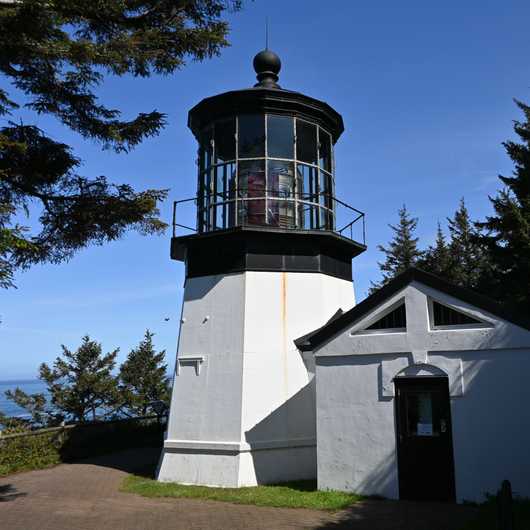Cape Meares

In 1886 James Suydham Polhemus, a U.S. Army Corps engineer who had settled in Oregon six years prior, was tasked with determining the best location for a light in the vicinity of Tillamook Bay. In this area there are two distinct peninsulas; Cape Lookout and Cape Meares.
Whilst Cape Lookout is protrudes further into the Pacific, it was determined that construction of a lighthouse there would be more challenging and costly due to its more rugged terrain and remote nature. Cape Meares on the other hand was much more accessible from Tillamook Bay. A short lighthouse atop the cliffs at Cape Meares would also provide much the same visibility and coverage, at a much reduced cost and with less chance of being so frequently obscured by fog.
With the site chosen, construction on the lighthouse began in 1889. It was completed and lit on January 1st 1890. Because of it's elevation on the headland, the lighthouse tower itself is the shortest in Oregon, at only 11.6 metres in height. The large lantern room houses a First Order Fresnel Lens built by Henry LePaute of Paris; which was shipped around Cape Horn and hoisted to the top of the cliff to be assembled.
The light was quite unusual in that it shone a fixed white light, interspersed by a red flash every minute.
Cape Meares Lighthouse was electrified in 1934, at which time the oil houses were demolished. 1963 saw major changes at light station, with the lighthouse being decommissioned altogether, and a new light being established on a nearby structure equipped with an automatic rotating Aerobeacon, which itself was decomissioned in 2014. Following several years of neglect and being left open to vandalism, the two keepers' houses were demolished in 1968.
The workroom located just behind the lighthouse is a replica of the original, first built in 1895. The original was demolished in 1963 or shortly thereafter, likely due to the automation of the light, only for the new building to be built in its place in 1978; this now serves as the visitor centre.
In January 2010 vandals drove down to the lighthouse and fired several rounds at the lighthouse, resulting in glass panes in the lantern room and several prisms in the lens to be damaged; eventually they were caught and charged. It was estimated that repairs could cost in excess of $500,000 - in this case the lens was not fully repaired, but damaged sections were glued, while other parts were replaced.
